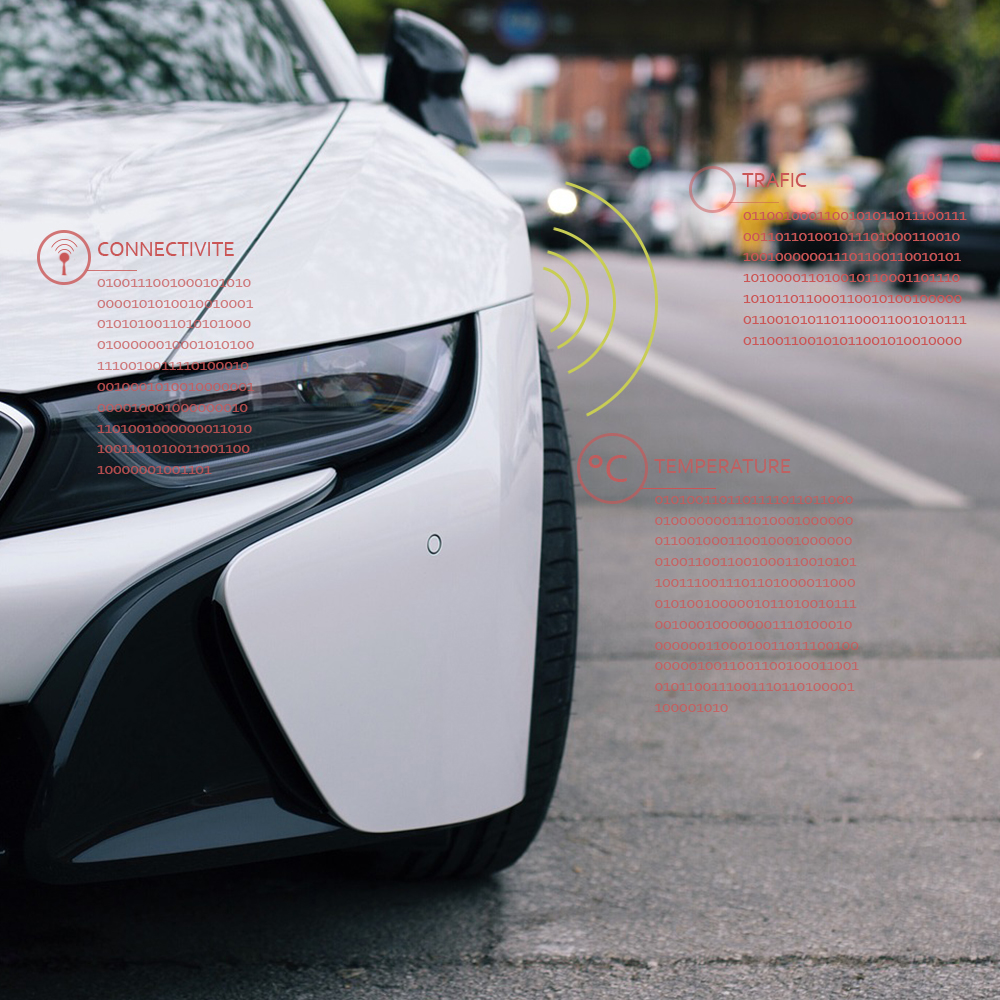With AutoMat, Europe hopes to adopt a marketplace for data from connected vehicles
Data collected by communicating vehicles represent a goldmine for providers of new services. But in order to buy and sell this data, economic players need a dedicated marketplace. Since 2015, the AutoMat H2020 project has been developing such an exchange platform. To achieve this mission by 2018 — the end date for the project— a viable business model will have to be defined. Researchers at Télécom Paristech, a partner in the project, are currently tackling this task.
Four wheels, an engine, probably a battery, and most of all, an enormous quantity of data generated and transmitted every second. There is little doubt that in the future, which is closer than we may think, cars will be intelligent and communicating. And beyond recording driving parameters to facilitate maintenance, or transmitting information to improve road safety, the data acquired by our vehicles will represent a market opportunity for third-party services.
But in order to create these new services, a secure platform for selling and buying data must still be developed, with sufficient volume to be attractive. This is the objective that the AutoMat project — began in April 2015 and funded by the H2020 European research programme — is trying to achieve by developing a marketplace prototype.
The list of project members includes two service providers: MeteoGroup and Here, companies which specialize in weather forecasts and mapping respectively. For these two stakeholders, data from cars will only be valuable if it comes from many different manufacturers. For MeteoGroup, the purpose of using vehicles as weather sensors is to have access to real-time information about temperatures or weather conditions nearly anywhere in Europe. But a single brand would not have a sufficient number of cars to be able to provide this much information: therefore data from several manufacturers must be aggregated. This is no easy task since, for historical reasons, each one has its own unique format for storing data.

Data from communicating cars could, for example, optimize meteorological measurements by using vehicles as sensors.
To simplify this task without giving anyone an advantage, the technical university of Dortmund is participating in the project by defining a new model with a standard data format agreed upon by all parties. This, however, requires automobile manufacturers to change their processes in order to integrate a data formatting phase. But the cost of this adaptation is marginal compared to the great potential value of their data combined with that of their competitors. The Renault and Volkswagen groups, as well as the Fiat research centre are partners in the AutoMat project in order to identify how to tap into the underlying economic potential.
What sort of business model?
In reality, it is less difficult to convince manufacturers than it is to find a business model for the marketplace prototype. This is why Télécom ParisTech’s Economics and Social Sciences Department (SES) is contributing to the AutoMat project. Giulia Marcocchia, a PhD student in Management Sciences who is working on the project, describes different aspects which must be taken into consideration:
“We are currently carrying out experiments on user cases, but the required business model is unique so it takes time to define. Up until now, manufacturers have used data transmitted by cars to optimize maintenance or reduce life cycle costs. In other sectors, there are marketplaces for selling data by packets or on a subscription basis to users clearly identified as either intermediary companies or final consumers.
But in the case of a marketplace for aggregated data from cars, the users are not as clearly defined: economic players interested in this data will only be discovered upon the definition of the platform and the ecosystem taking shape around connected cars.”
For researchers in the SES department, this is the whole challenge: studying how a new market is created. To do so, they have adopted an effectual approach. Valérie Fernandez, an innovation management researcher and director of the department, describes this method as one in which “the business model tool is not used to analyze a market, but rather as a tool to foster dialogue between stakeholders in different sectors of activity, with the aim of creating a market which does not currently exist.”
The approach focuses on users: what do they expect from the product and how will they use it? This concerns automobile manufacturers who supply the platform with the data they collect as much as service providers who buy this data. “We have a genuine anthropological perspective for studying these users because they are complex and multifaceted,” says Valérie Fernandez. “Manufacturers become producers of data but also potential users, which is a new role for them in a two-sided market logic.”
The same is true for drivers, who are potential final users of the new services generated and may also have ownership rights for data acquired by vehicles they drive. From a legal standpoint nothing has been determined yet and the issue is currently being debated at the European level. But regardless of the outcome, “The marketplace established by AutoMat will incorporate questions about drivers’ ownership of data,” assures Giulia Marcocchia.
The project runs until March 2018. In its final year, different use cases should make it possible to define a business model that responds to questions relating to uses by different users. Should it fulfill its objective, AutoMat will represent a useful tool for developing intelligent vehicles in Europe.
[divider style=”normal” top=”20″ bottom=”5″]
Ensuring a secure, independent marketplace
In addition to the partners mentioned in the article above, the AutoMat project brings together stakeholders responsible for securing the marketplace and handling its governance. Atos is in charge of the platform, from its design to data analysis in order to help identify the market’s potential. Two partners, ERPC and Trialog, are also involved in key aspects of developing the marketplace: cyber-security and confidentiality. Software systems engineering support for the various parties involved is ensured by ATB, a non-profit research organization.
[divider style=”normal” top=”20″ bottom=”20″]




Leave a Reply
Want to join the discussion?Feel free to contribute!